Can I share my review in a humorous, self-deprecating, observational voice reminiscent of a witty essayist, without imitating any single author too closely?
Why I Chose the Cregrant3D Soleyin Ultra PLA (Black and White)
I bought the Cregrant3D Soleyin Filament 1.75mm Ultra PLA Filament for 3D Printing because it promised something fairly audacious: blazing speed (30–300 mm/s), accuracy within ±0.02 mm, eco-friendliness, and a finish that wouldn’t curl up at the edges like a potato chip in a warm car. It also comes in black and white, which for me is a very civilized pairing—like tuxedos for a spool rack.
I print a lot of functional bits, jigs, and little gifts that suggest I care more about my friends than I actually do. Fast, reliable PLA matters to me. So I put this Soleyin by Creality filament through the kind of tests I usually only reserve for houseguests: what happens when things get hot, loud, and surprisingly sticky.
My Setup and Testing Printers
I tested this filament on two printers: a direct-drive machine tuned for speed and a more modest Bowden setup that lets me experience life as it is for most people—slower, but still hopeful. I used slicers you’d expect, tweaking settings from sensible to slightly unhinged to see where this filament behaves and where it tries to teach me humility.
I printed black and white spools in equal measure. The white is a terrific choice for prototypes and art pieces, while black hides sins like stringing and the occasional mistaken elbow to the hotend.
Cregrant3D Soleyin Filament 1.75mm Ultra PLA Filament for 3D Printing High Speed 30-300mm/s Accuracy +/- 0.02mm, (2.2lbs), Fit Most FDM 3D Printer, Soleyin by Creality Filament Black and White
$22.99 Only 20 left in stock - order soon.
Unboxing and First Impressions
The spools arrived vacuum-sealed with desiccant, tidy as a first day of school. I’ve opened filaments that came off the line looking like they survived a minor scuffle, but these Soleyin spools were neat and dry, and the coil wasn’t playing jump rope across the flange.
The label clearly stated the specs: 1.75 mm diameter, 1 kg (2.2 lbs) spool, dimensional tolerance ±0.02 mm, and a speed range up to 300 mm/s. If you’ve ever wished a spool would casually brag to you before you load it, this one obliges without being obnoxious.
Spool Design and Neat Winding
The company mentions an EPC automatic winding process that keeps the filament orderly, and I can vouch for tidy stacking with minimal crossover. That predictability matters more than it seems. Tangles are like bad breakups—they usually start months earlier with a single, small knot you decide not to address.
Across the entire spool, I didn’t encounter one genuine tangle. The feeding was consistent, and the spool unspooled without lurching fits. This set the stage for smooth printing, even at higher feed rates.
Filament Diameter and Tolerance: ±0.02 mm Measured
The stated tolerance is ±0.02 mm, and my calipers measured my black and white spools between 1.74 and 1.76 mm with smooth sections that felt uniformly round. I took measurements at intervals—yes, like a person with too much time and a drawer full of calipers—and the results were consistent.
This consistency directly affects extrusion. If your walls look like they’re breathing, it’s often inconsistent diameter messing with your flow. I didn’t see that here. The walls on my calibration cubes were steady, without zebra-like bands or that “one layer’s on a juice cleanse” look.
Speed: Printing from 30 to 300 mm/s
The big headline claim is speed: up to 300 mm/s. That’s an eye-catching number. It’s like saying your toaster can brown bread at the speed of gossip. To be fair, speed is also a larger conversation about accelerations, jerk, cooling, and the printer’s mechanical limits. But the filament plays a crucial role.
On my tuned, input-shaper-enabled setup, I hit 250–300 mm/s for infill and perimeters in the 150–220 mm/s range with surprisingly clean results. On the more modest printer, 80–120 mm/s was the sweet spot. On both machines, Soleyin Ultra PLA fed smoothly and didn’t choke when I turned up the speed like someone who’s spent years politely complying with all posted signs and suddenly merges onto the Autobahn.
How I Tuned for High-Speed
For fast printing, I bumped nozzle temps slightly higher than I would for slower PLA—generally 210–225°C on a brass 0.4 mm nozzle. I kept the bed around 55–60°C. Cooling stayed strong—100% after the first few layers—because this Ultra PLA likes a breeze when it’s sprinting.
I calibrated flow rate, pressure advance, and retraction per printer. If you’re using input shaping, you can push this filament hard while maintaining respectable perimeters. Without it, you can still print fast—just not quite “weekend project becomes hour project” fast. The filament didn’t limit me; my printer configuration did.
Real-World Time Savings vs Typical PLA
The product claims up to a 73% time savings compared with ordinary PLA. On my tuned printer, comparing my usual “good quality” profile to the high-speed profile, I saw about a 50–65% reduction in build time on practical objects: brackets, phone stands, hinging boxes, and a few slightly too-ambitious vases.
On the slower printer, time savings were more modest—about 20–35% faster—mostly because I hit the wall of motion constraints and cooling before the filament reached its limit. Even so, I got cleaner results at higher speeds than I usually expect from mid-shelf PLA.
Print Quality and Surface Finish
I love the surface finish on both black and white spools. The white has a clean, semi-matte look that softens layer lines and photographs well. The black is slightly glossier and hides imperfections like a well-placed scarf. Together, they’re a bit like comedy partners: one subtle, one dramatic, both committed.
Layer adhesion was strong. I printed a 3-wall, 20% gyroid infill bracket in white and couldn’t break it by hand without looking slightly unhinged. On black, thin parts felt crisp and finished. The filament lays down evenly and doesn’t ooze into an overly shiny, “melted candy” sheen unless the nozzle is very hot or the print is slow.
Small Parts, Overhangs, and Bridging
Bridges were respectable with adequate cooling and moderate speeds. For clean overhangs at 60° and beyond, I kept the nozzle around 210–215°C and fan at max after layer two. I also tightened retractions slightly to avoid wisps on small details.
Tiny parts—gears, clips, and the kind of test trinkets that make you question your life choices—printed with sharp edges and little blurring. The white particularly shows detail nicely, which helps when I’m trying to convince someone a 30-minute part was actually a careful and heroic undertaking.
Benchy, Calibration Cube, and Articulated Model Results
Benchy, patron saint of printers, came out with clean overhangs and crisp text on the stern at 150 mm/s perimeters. At 200+ mm/s, I saw predictable softening on extreme overhangs but nothing catastrophic. The smokestack hole remained round and the bow didn’t sag into an interpretation of remorse.
Calibration cubes measured tight: 20.02–20.05 mm on X and Y, 20.03–20.06 mm in Z. That’s without compensating steps, just slicer tuning and consistent extrusion. My articulated lizard printed in white flexed smoothly with carefully controlled stringing, which I tuned down with temperature and retraction.
Warping, Adhesion, and Shrinkage
Soleyin Ultra PLA behaved like a PLA should: low shrinkage and minimal warping. No brim was needed on well-leveled beds for models with decent contact patches. On trickier, thin parts, I used a light brim or a narrow raft and got stable results without edge lift.
First layers were buttery with a 0.2 mm height and a slightly squished line. It didn’t demand glue stick, but I tried it anyway because I have a drawer full of adhesives and it feels rude not to use them. It stuck well on PEI and textured sheets at 55–60°C.
Bed Adhesion Tips
- Level the bed carefully and set your Z-offset so the filament lays flat without being pressed into humiliation.
- Keep the first layer slow: 20–30 mm/s, with the nozzle around 210–215°C and the bed at 60°C.
- If you see edges lifting, add a brim, increase bed temp by 5°C, or reduce part cooling for the first few layers to about 50%.
Clogging, Stringing, and Bubbles
I printed through a full kilogram spool in black and another in white without a single clog. The raw material feels clean and uniform—no squeaks, no chalky sections. Feeding was smooth even at higher flow rates that would make lesser filaments cough modestly and ask to lie down.
Stringing was low to moderate depending on settings. At 210–215°C with 0.8–1.2 mm retraction (direct drive), stringing kept itself to the polite end of the spectrum. At 220–225°C and very fast moves, a few wisps showed up on small islands, nothing a quick pass of a heat gun or a fingernail couldn’t fix.
Dryness and Storage
Both spools arrived dry, which is more than I can say for certain muffins and one bag of rice in my pantry. If you live somewhere humid or your printer sits near a kettle you believe you don’t use often, store the spools with desiccant in a sealed container.
When I ran the white spool through a dryer at 45°C for four hours (because I was printing some very detail-sensitive parts), the surface finish tightened up, and stringing dropped to near-zero on complex minis. It’s not necessary out of the bag, but if you chase perfection, drying helps.
Dimensional Accuracy and Tolerance
The advertised ±0.02 mm tolerance is believable based on caliper measurements, and it showed in fitment tests. I printed parts that press together—peg-in-hole connectors, snap-on cable guides, and one elaborate lid that implies I could organize my life if I really tried—and the parts fit without me having to pretend I meant them to be that tight.
With good slicer profiles, holes printed within 0.1–0.15 mm of intended size, which is typical for FDM. The consistent filament diameter helps keep the extrusion predictable so you’re not compensating for a wiggly flow rate.
Real Measurements and Fit
- 20 mm calibration cube: 20.02–20.06 mm on each axis
- 10 mm vertical cylinder (hole): printed around 9.85–9.9 mm without hole compensation
- Press-fit peg: 0.2 mm clearance was comfortable; 0.1 mm was “tap with your fingernail” snug I printed the same parts in black and white and saw no meaningful differentiation in dimensional outcomes. Surface tactility varied—white looked slightly more matte—but the sizing was consistent.
Color Options and the “Color Game” Idea
The product listing talks about color variety and creative combinations, which frankly sounds like a dating profile but for spools. My unit was black and white, which I prefer for functional prints and crisp prototypes. If you’re the kind who needs a rainbow army of dragons, Soleyin seems to offer multi-color sets too.
The color consistency was strong across the spool. The black never went gray or chocolate, and the white didn’t drift warm or cool between prints. It makes batch printing look deliberate instead of “I used whatever was left on the rack.”
How the Black and White Pair Works for Me
- Black for functional parts that get handled, like handles, clips, tool mounts, and brackets.
- White for showpieces, architectural studies, lithophanes, and parts I plan to paint later. I also like pairing them in single prints by pausing to swap mid-layer. White text inlaid in a black plate looks handsome. Black lids on white containers are elegant in a way that makes me feel like I should wear nicer socks.
Compatibility Across FDM Printers
This is a 1.75 mm PLA with broad compatibility. I ran it through two printers and lent a bit to a friend with a very entry-level machine prone to squeaking like a door in an old movie. He printed a card holder at 60 mm/s without a single jam and then immediately spent the rest of the weekend looking for things he “needed” to organize.
The consistent diameter and lack of debris means this filament runs well through Bowden and direct-drive setups, 0.2–0.6 mm nozzles, and stock hotends that never asked to print at Formula 1 speeds.
Bowden vs. Direct Drive
- Direct drive: Fewer retraction issues, particularly at high speeds; 0.8–1.2 mm retraction worked well.
- Bowden: Use 3–5 mm retraction and consider slowing perimeters to 60–90 mm/s. The filament still holds detail well. Both setups benefited from strong part cooling, especially on smaller layers and sudden direction changes.
Noise, Smell, and Safety
The sole aroma was the faint sweetness of PLA—nothing objectionable. It didn’t smell like a chemical factory took up residence in my home. Still, I keep ventilation moving because common sense never ruined a print.
The filament is plant-derived (corn and potatoes), which means it’s made from renewable sources. It’s not composting itself in your hands, but it feels nice to use something that’s eco-friendlier than many plastics.
The Numbers at a Glance
Here’s a quick reference table I wish every product listing had tattooed somewhere tasteful.
| Attribute | Cregrant3D Soleyin Ultra PLA (Black and White) |
|---|---|
| Filament diameter | 1.75 mm |
| Tolerance | ±0.02 mm (measured 1.74–1.76 mm) |
| Spool weight | 1 kg (2.2 lbs) |
| Material | PLA (plant-derived) |
| Recommended print speed | 30–300 mm/s (printer-dependent) |
| Typical nozzle temp | 200–225°C (I liked 210–215°C) |
| Bed temperature | 50–60°C (I used 55–60°C) |
| Cooling | 100% after layer 2 (reduce to 50% on tricky first layers) |
| Finish | Semi-matte white, slightly glossy black |
| Warping | Low; brim rarely needed |
| Clogging | None observed across two full spools |
| Compatibility | Most 1.75 mm FDM printers |
| Packaging | Vacuum-sealed with desiccant; neat winding |
| Primary use cases | Fast prototyping, functional parts, aesthetic models |
| Product name | Cregrant3D Soleyin Filament 1.75mm Ultra PLA Filament for 3D Printing High Speed 30-300mm/s Accuracy +/- 0.02mm, (2.2lbs), Fit Most FDM 3D Printer, Soleyin by Creality Filament Black and White |
Pros and Cons
I’m happier when things are clear. A list helps me pretend I’m the sort of person who decides rationally.
Pros:
- Genuinely fast without losing its composure; 150–220 mm/s perimeters looked great on a tuned machine
- Accurate diameter and predictable flow; excellent for functional fits
- Low warping and strong first-layer adhesion
- Clean, tidy winding—no tangles across my spools
- Black and white both look professional; white is great for painting and photos
- Eco-friendlier PLA base and low odor
Cons:
- The highest speeds require a well-tuned printer; don’t expect miracles on a wobbly setup
- Slight stringing at very high temps/speeds unless retractions and temps are dialed in
- Like all PLA, heat resistance is limited; don’t put a white car mount in a hot car and expect a fairy tale ending
Tips to Get the Best Results
Sometimes the difference between a crisp print and a small plastic omelet is a handful of settings and a bold decision to level the bed.
- Start at 210–215°C nozzle, 60°C bed, 100% fan after layer 2.
- First layer: 0.2 mm height, 20–30 mm/s, 50% fan; brim if edges suggest they might go wandering.
- Retraction: 0.8–1.2 mm (direct), 3–5 mm (Bowden); 25–40 mm/s retraction speed.
- Flow calibration: Run a flow test; aim for consistent wall thickness without bulges.
- Pressure advance/input shaping: If your firmware supports it, you’ll get cleaner corners at high speed.
- Drying: Not necessary out of the bag, but 3–4 hours at 45°C can reduce stringing on ultra-detailed prints.
My Slicer Profile (Starting Points)
- Perimeter speed: 120–180 mm/s on a tuned machine; 60–90 mm/s on a modest one
- Infill speed: 180–250 mm/s if your motion system cooperates
- Travel speed: 180–220 mm/s to reduce ooze time
- Acceleration: 3000–6000 mm/s² on a sturdy printer; 1000–2000 mm/s² on a lighter one
- Walls: 2–3 perimeters; 0.12–0.28 mm layer height depending on detail These are starting points. I nudge temperature and speed based on the model. Fine miniatures get the velvet rope treatment; functional brackets get the “let’s move” plan.
Troubleshooting Quick Guide
- Edges lifting: Increase bed to 60–65°C, add a brim, lower fan for first 3 layers.
- Stringing on tiny islands: Lower nozzle temp by 5°C, increase retraction slightly, increase travel speed.
- Elephant’s foot: Reduce bed temp after first layers, increase Z-offset by 0.02 mm, or add a first-layer chamfer in the model.
- Inconsistent walls: Check filament path and spool tension; confirm your E-steps and flow calibration; ensure filament diameter is set correctly (1.75 mm) in slicer.
How It Compares to Regular PLA, PLA+, and PETG
Against regular PLA, Soleyin Ultra PLA feels more cooperative at higher speeds and keeps details intact even as you push past 100 mm/s. PLA+ often trades a bit of rigidity for toughness, but this Ultra PLA still felt sturdy in real-world parts. It doesn’t pretend to be heat-resistant like PETG, nor does it adopt PETG’s tendency to string like a haunted violin.
If you build parts destined for the sun or a dashboard, PETG or ABS still wins on heat, but for most brackets, organizers, prototypes, and display pieces, this Ultra PLA is my current first pick when I want them done before my tea gets cold.
Who Should Buy It
- Makers who want faster prints without the chaos, and who are willing to spend 20 minutes tuning profiles
- People who care about dimensional accuracy in functional parts
- Beginners who want an easy, forgiving PLA that doesn’t demand a sacrifice to the gods of bed adhesion
- Designers who need clean white for painting or photographs and a deep black that always looks finished
Long-Term Reliability
Some filaments are sprinters: good for a few prints, then they cough up a clog or a brittle patch. I ran two spools over multiple weeks, stopping and starting like a person trying to form better habits. No brittleness, no mid-spool personality shifts, and no sudden need to over-extrude to maintain layer lines.
I printed tall vases (vase mode at 0.2–0.28 mm), fast infill-heavy tool trays, and a parade of calibration things that made my desk look like it belonged to someone with a plan. Every time I returned to a project after a week, the filament loaded and behaved the same way it had before. That consistency matters if your work depends on not babysitting every print.
Price and Value
Value is tied to trust. If a filament saves me reprints, time fussing with temperatures, and fits my parts together without a mallet intervention, I call it a win. This Soleyin by Creality filament gave me premium behavior without premium drama.
The time savings alone justify it for me. I can start a print after dinner and not have it still explaining itself in the morning. And because the dimensional accuracy is solid, I rarely reprint for fit—my least favorite kind of reprint, right after the kind where I forget supports entirely.
Real Project Notes: What I Printed and How It Went
- Offset spatula for 3D printer bed: White, 0.2 mm layers, 4 walls, 30% infill. Strong, clean edges, good rigidity. I try not to anthropomorphize my tools, but this one seemed cheerful.
- Cable guide with snap fit: Black, 0.2 mm layers, 3 walls. The snap engaged with a satisfying click. No post-processing required except a victory lap.
- Phone stand with logo inlay: Black body with a mid-print color change to white text. The result made me look far more professional than I am in most aspects of my life.
- Benchy at speed: White, 150 mm/s perimeters, 220°C nozzle. A bit of softening under the arch, otherwise everything where it should be.
- Lithophane nightlight: White, 0.12 mm layers, high flow consistency needed. Crisp, lovely result—one of those prints that makes you feel like an inventor even though you downloaded the model.
A Few Words on Sustainability
PLA is made from renewable plant resources, and Soleyin calls out corn and potatoes in their materials. I like that. I don’t suggest composting your prints in the backyard as a party trick, but it’s nice knowing the source isn’t fossil-heavy. Combined with tidy packaging and dry storage, the whole experience felt considered, not slapdash.
Where It Surprised Me
I expected the speed claims to be aspirational, like my promise to finally label all the bins in my workshop. Instead, on a tuned printer, the filament pulled its weight. I printed some beautifully crisp parts at speeds that used to leave me with flappy corners and regret. The high-speed perimeters looked better than I ever had a right to expect from PLA that doesn’t identify as an exotic blend.
The other surprise was the neatness of the winding. I’ve dealt with tangled spools that turned the last 200 grams into a puzzle I didn’t want to solve. Here, the line lay so uniformly I started trusting it like a friend who always shows up five minutes early and texts from the driveway.
Who This Filament Is Not For
If you need parts that live in hot environments—cars in summer, near ovens, or attached to the sun—you’ll want materials with higher heat deflection like PETG, ABS, ASA, or nylon. And if you refuse to tune anything and want to print at 300 mm/s out of the box on a wobbly machine, you’ll be annoyed at the very laws of physics rather than the filament.
If, however, you’re willing to run a temperature tower, tweak retraction, and do a calibration cube or two, this Ultra PLA pays you back with consistency and speed.
The Quiet Joy of Black and White
There is something deeply satisfying about a shelf of prints in just black and white. It feels like a creative constraint—a way to make design do the heavy lifting rather than the confetti of color. The white Soleyin becomes a blank canvas for paint or light, the black a dignified finish that doesn’t shout for attention.
Put them together in a single model, and suddenly your prints look like they’re wearing their Sunday best. I’ve used the white for small figurines, architectural mockups, and little signs that suggest order will break out any minute now. I’ve used the black for brackets, gadgets, and the occasional experimental hinge that either works beautifully or teaches me something about geometry and humility.
Final Thoughts
The Cregrant3D Soleyin Filament 1.75mm Ultra PLA Filament for 3D Printing lives up to its promise more than most materials that boast about speed. It’s a well-behaved PLA with the temperament for high-speed printing, the accuracy to fit functional parts, and the surface finish that makes even quick prototypes look considered.
I had no clogs, no tangles, and only minor stringing at the highest temperatures and speeds. Warping was negligible. The dimensional tolerance proved itself in prints that clicked together like they had been friends for years. And the black-and-white duo was everything I needed for serious projects and the kind of playful experiments that accidentally turn out beautifully.
If your printer can handle it, this filament will go fast with you. If your printer is more sensible, it will still give you clean, dependable results without theatrics. I recommend it to beginners who want a smooth start, to enthusiasts chasing speed, and to anyone who values their time almost as much as they value a tidy first layer.
I didn’t just get good prints; I got more of them, faster, and with less fuss. That, to me, is the highest compliment I can give a spool of PLA: it quietly made me feel like I had my act together. And for a few splendid afternoons, I almost did.
Disclosure: As an Amazon Associate, I earn from qualifying purchases.






